There was no shortage of expectation placed on Timothée Pembélé (182cm/5’11”, 72kg/158lbs) when he made his debut for Paris Saint-Germain last season. Around the time he burst onto the scene for the Ligue 1 giants, he was described as “one of the best of his generation” and a “silent leader” by his under-15s coach, Said Aigoun, while the PSG academy product worked his way into current Chelsea manager Thomas Tuchel’s and subsequently former Tottenham Hotspur boss Mauricio Pochettino’s first-team plans at Le Parc des Princes.
Pembélé ultimately enjoyed more game time under Tuchel before his departure than he went on to enjoy under Pochettino at PSG but such is the 19-year-old’s high level of potential that he didn’t have much difficulty finding a club to take him in on loan for the 2021/22 campaign, with Pembélé finding a home at PSG’s Ligue 1 rivals Girondins de Bordeaux this term.
The PSG academy product has made a big step in his development this season, becoming a first-team regular for Bordeaux under former Switzerland and Lazio manager, Vladimir Petković. Pembélé has made the right wing-back spot his own under Petković, with the Bosnian-Swiss manager opting for a three-centre-back shape most of the time to start this season — his first as manager of Bordeaux having been in charge of the Swiss national team for the European Championships this past summer. This has been something of a change of position for Pembélé, with the France U20 international having primarily played as a centre-back during his days as a youth player with PSG.
Despite his history at centre-back, Pembélé’s ability going forward, especially his crossing, has been the biggest positive to his game this season, so much so that the 19-year-old has, at present, completed the highest number of successful offensive actions (5.65 per 90) of any right-back/right wing-back in Ligue 1 this term. This tactical analysis and scout report will highlight what exactly it’s been about Pembélé’s game that has made him such a positive asset for his team going forward this season — his first proper campaign in senior football. Additionally, this scout report will highlight some key areas of improvement for Pembélé to focus on moving forward if he is to build on his eye-catching start to life in Ligue 1 and return to PSG next season to provide competition for Les Parisiens’ €60m superstar right-back, Achraf Hakimi.
Role in ball progression
Pembélé’s role in ball progression with Bordeaux typically sees him take up an advanced position on the right-wing, where he provides the offensive width for his team. This is similar to how PSG’s full-backs operate — they’ll generally get high and wide during the ball progression phase, assuming the widest roles within their side’s offensive frontline.
When playing with three centre-backs, which is when Pembélé usually plays on the right, Bordeaux typically attack in something resembling a 3-2-5 shape with the three centre-backs sitting deepest behind two central midfielders and the wing-backs pushing forward to join the attack from the wings. When playing with two centre-backs — less common for Les Girondins this season — Pembélé has gotten less game time. He’s clearly been preferred as a wing-back rather than as a full-back, as this creates more defensive protection behind the teenager, allowing him to defend more aggressively while giving him more license to commit to attacks. This helps to accentuate some of the PSG loanee’s strengths while masking weaknesses.
In build-up, the ball often progresses through Bordeaux’s wide centre-backs. If progression through central midfield is then blocked off for one reason or another, the wide centre-backs will often use the wing-backs to continue moving upfield. This sees a lot of link-up via short passes or through balls between Bordeaux’s right centre-back and Pembélé at right wing-back. However, we’ve also seen Bordeaux’s left centre-back find Pembélé in space with a long switch from the opposite side of the pitch at times this season, aiming to launch the wing-back into space on the wing with the opposition’s defensive block pulled to the other wing. To make the most of both these possibilities, Pembélé needs to remain high and wide, alert to the position of the ball along with the space around him while making intelligent movements to help make him a better option for teammates.
The Frenchman is good at achieving all of this and generally plays an important role in his side’s ball progression. This section of analysis will focus on Pembélé’s off-the-ball movement during ball progression, ability to receive the ball well in this phase to promote ball progression, and the benefit of his rapid pace.
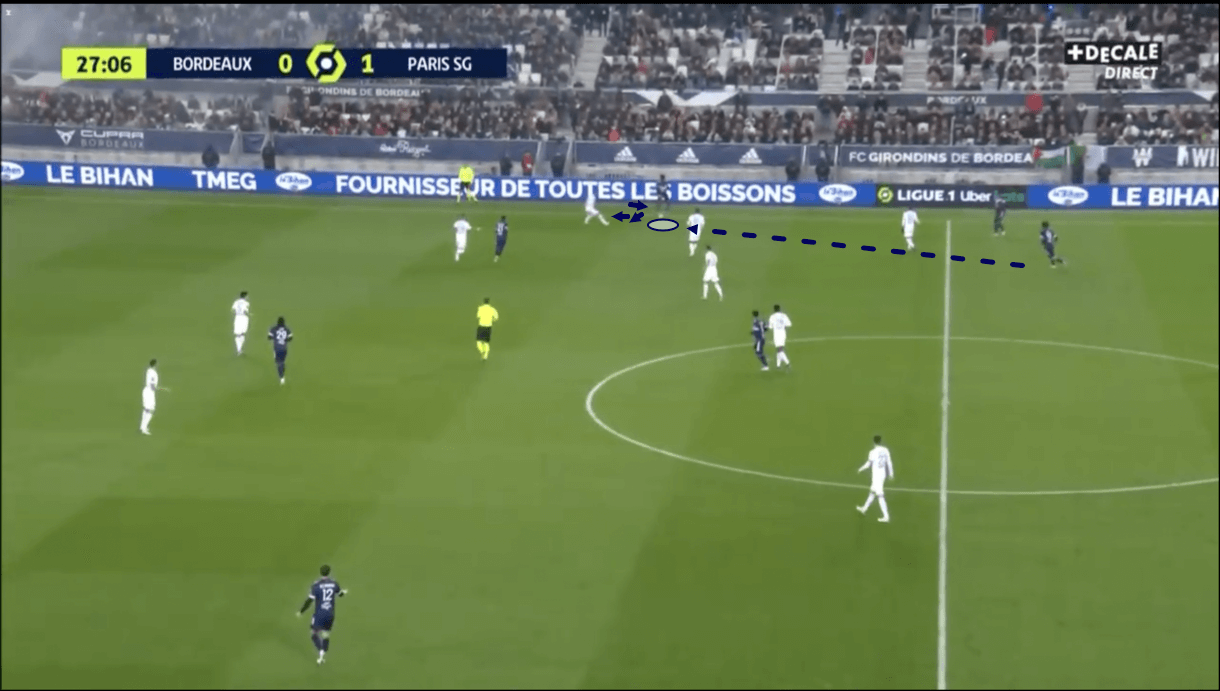
Figure 1 shows an example of Pembélé receiving a pass to feet high on the right wing from the right central midfielder. Just before this image, the ball moved from Bordeaux’s backline into midfield and as this midfielder turned to assess his forward passing options, Pembélé dropped slightly to create some separation from the nearest defender and make himself a more attractive option for the midfielder.
As the ball arrives at his feet, the wing-back cushions it nicely with the inside of his right foot while placing his left foot out in front and pivoting off it to face the opposition’s goal. This subtle movement occurs in an instant but is key to getting Bordeaux’s attack continuing upfield and preventing Les Girondins from being forced backwards.
It’s also worth noting that Bordeaux’s right central midfielder played a well-weighted and accurate pass to the wing-back’s furthest forward foot here. This was a good pass selection for getting the team progressing upfield. Sometimes, you do see players send the ball out wide to the wide man’s nearest foot, as opposed to the furthest forward one, which makes it much more difficult for the receiver to turn and face forward, naturally leading to the ball moving backwards and progression breaking down. That’s not the case here, however, both thanks to Pembélé’s movement and the passer’s pass selection and technique.
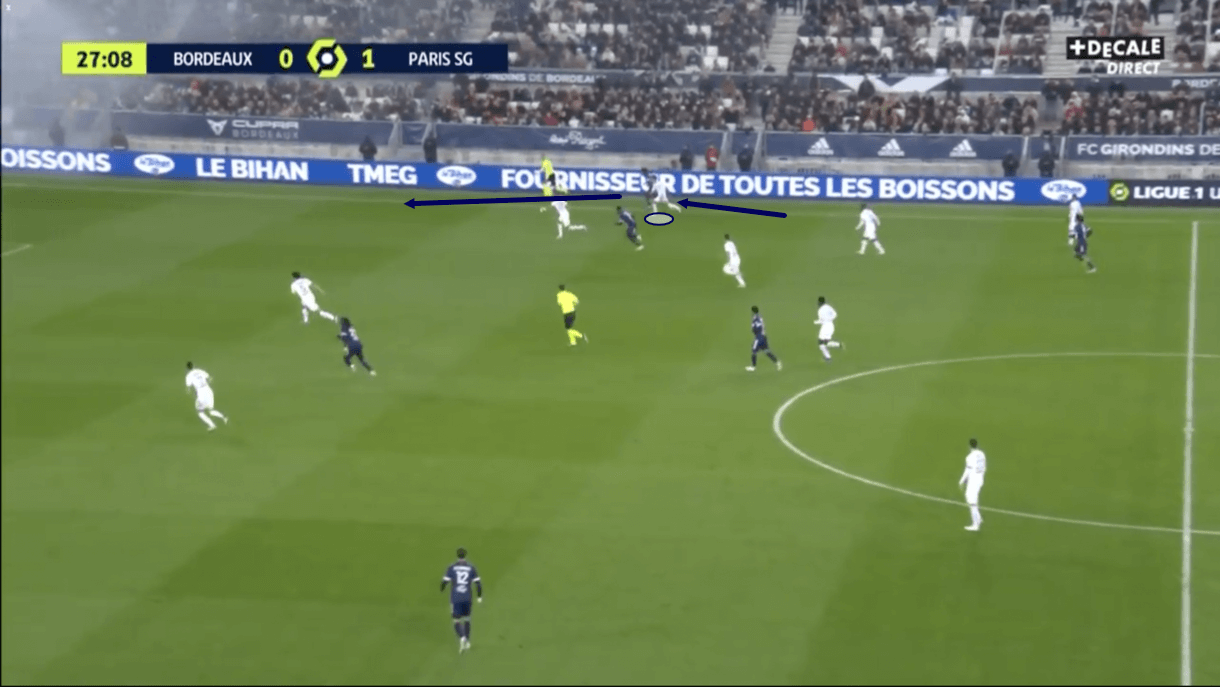
As this passage of play moves on into figure 2, we see that thanks to his movement and turning on receiving the ball with his right foot, Pembélé was able to get facing forward before the nearest defender could close him down. This then created the opportunity for the wing-back to take the opposition full-back on, which he gladly takes. As we can see from the image above, the Bordeaux man opted to take the ball on the outside of the full-back, knocking it down the line and aiming to speed past the left-back in the style of a traditional right-winger.
It’s common to see Pembélé rely on his pace quite a lot; he’s a pacy sprinter who’s capable of accelerating rapidly too. As a result, a sight like the one we see in figure 2 isn’t unfamiliar to Bordeaux fans this term. Pembélé has some impressive technical dribbling quality, as we’ll go on to discuss, but more often than not, when aiming to take the ball past defenders, he’ll fall back onto his physical qualities and aim to beat the challenger with pace, rather than technique. On one hand, if you’ve got it, why not use it? Pembélé is extremely quick and has demonstrated ability to blast past most opposition players, especially when he’s facing forward and the opposition player will have to turn to face the same direction, giving Pembélé an extra edge over the opponent.
However, as mentioned before, Pembélé has technical quality too and would do well to continue testing his technical ability in high-level competitive situations while avoiding becoming overly reliant on his pace. He won’t always have the space to accelerate into and may come up against equally rapid defenders at some point. That said, at present, his pace often gets the job done for Bordeaux, as was the case in figure 2, where he successfully progressed his side up the wing.
It’s common to see the right-footer take the ball on the outside of opposition defenders on the right-wing. Again, like a traditional winger, he is happy to stay wide before progressing into a crossing position, which can naturally come while moving like this and positioned on the same wing as his preferred foot. So, Pembélé’s intelligent movement, balance to turn, pace to beat the man and technical quality to cross can all combine to form a pretty dangerous threat on the right-wing. In terms of his ball progression, these qualities have combined to help Pembélé complete the highest number of progressive runs (3.89) of any right-back/right wing-back in France’s top-flight this season, highlighting his suitability for this key role in ball progression and how much of an asset his ball-carrying ability is in moving his team upfield.
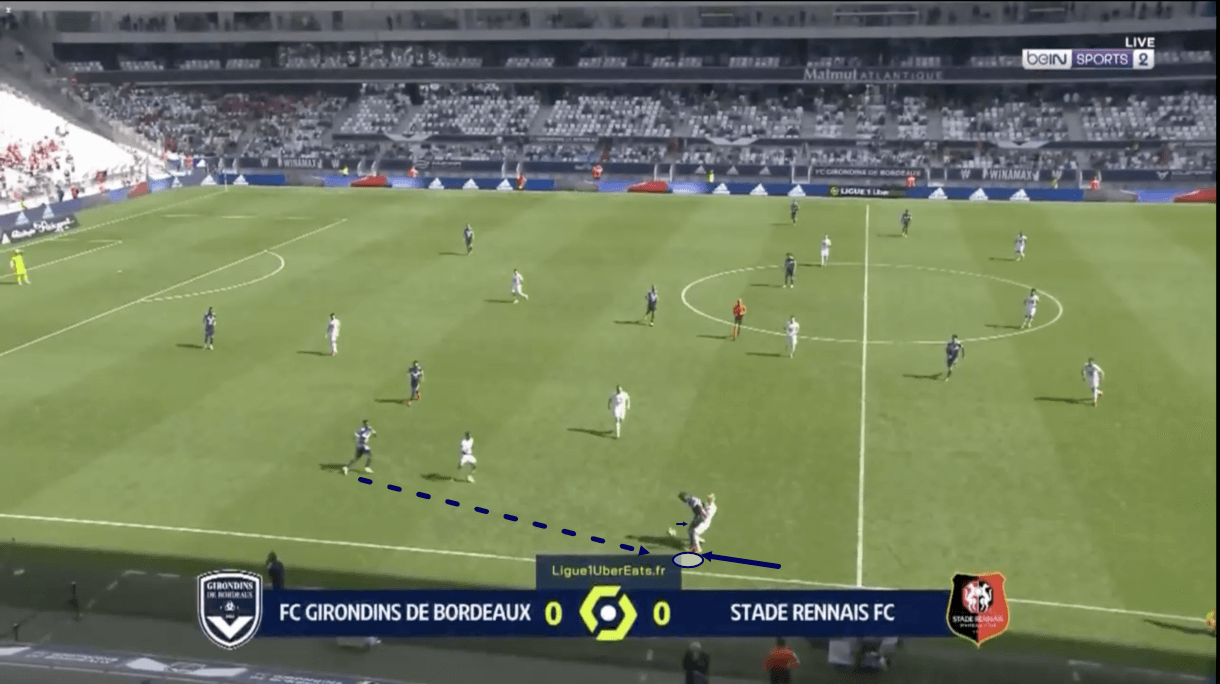
Pembélé is well aware of the important role he plays in ball progression. He knows that how he receives the ball, his positioning and his decision-making after receiving are all very important to the continuation of an attack while avoiding a breakdown. This is why he made such an effort to create separation, receive on the furthest forward foot, and quickly pivot to face the opposition’s goal in figure 1. The 19-year-old generally tries very hard to make sure his team continues progressing upfield. However, at times, whether it’s through good aggressive pressing from an opposition full-back or through a poorer pass, being prevented from turning and put in a more negative position is unavoidable. We see an example of this in figure 3.
Just before this image, the wing-back received the pass to feet on the right wing but he was prevented from turning as an opposition full-back got very tight to him; he was unable to create the desired separation through his off-the-ball movement. It’s common to see Pembélé stifled like this on occasion but even in these situations, the teenager regularly demonstrates some intelligent, subtle movement to continue his side’s chances of progressing upfield and avoid playing a negative pass that would increase pressure on his side in a vulnerable position.
Thanks to his spatial awareness, Pembélé is aware of the pressure coming from the opposition full-back behind him. As a result, he doesn’t open up his body to receive the ball and turn — which would give the opposition player a chance to intercept — instead, he opts to back into the incoming defender while receiving. This uses the defender’s momentum against him, allowing the wing-back to manufacture some contact from behind. After contact is made, Pembélé hits the deck and successfully wins a free kick for his side.
This highlights another way that Pembélé can create an opportunity for his side to continue progressing upfield while avoiding getting forced backwards or caught in possession when turning to play forward proves impossible. This bit of intelligence to just back into the incoming defender and draw a foul out of them through their momentum is something we see the 19-year-old pull off semi-regularly, when necessary. Again, this highlights Pembélé’s impressive ability to receive the ball, spatial awareness and effective off-the-ball movement that helps him to reliably perform his role in ball progression to a high standard.
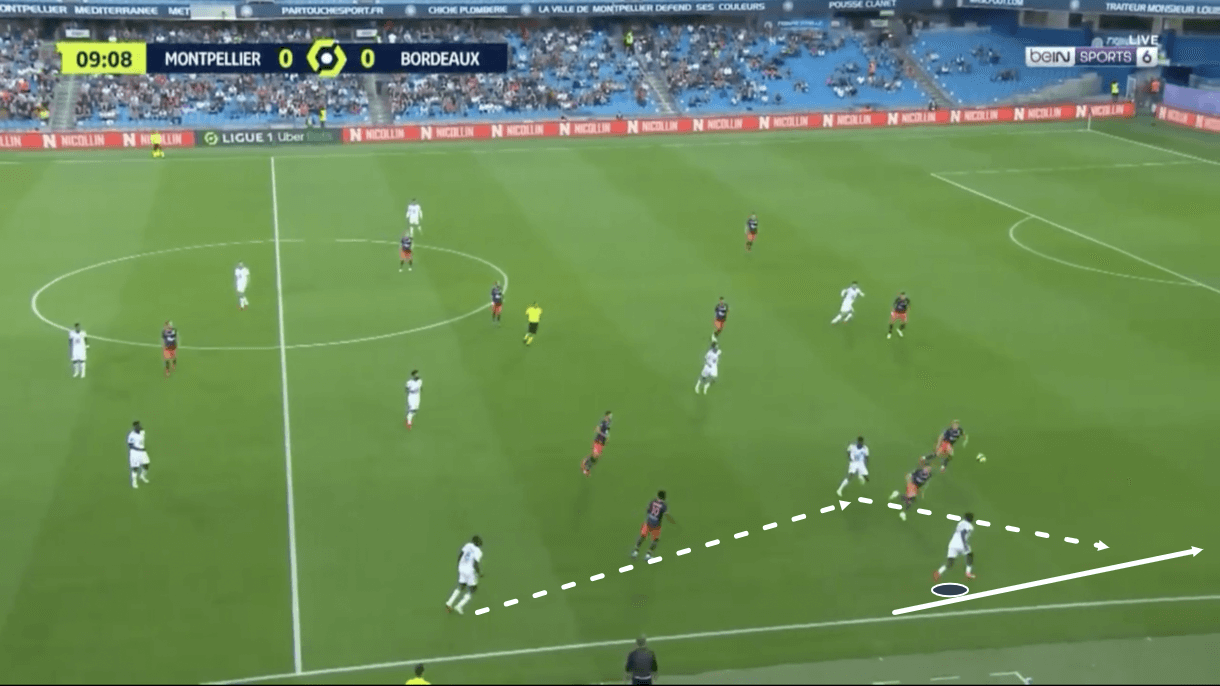
To pick up on one last element of Pembélé’s role in ball progression, the wing-back doesn’t always have to receive the ball to feet. He can also get released into space, as was the case in figure 4, which can be the most effective way of all to take advantage of the teenager’s attacking threat, including his blistering pace.
Just before this image, the ball was played from the player in the more traditional right-back position into the right-winger positioned quite narrow. This attracted pressure from the opposition’s left-back, which created space for Pembélé to drive into on the wing. Bordeaux took advantage of this space by sending the ball through from the winger to Pembélé. From here, the wing-back could speed away, as he receives the ball facing forward with space to run into. This, combined with his rapid pace, is a recipe for disaster for the opposition. If Pembélé can get released into space like this, then generally, he’ll be gone and speeding away into a crossing position. This is another reason why he poses a considerable threat from the wing. On one hand, here, if the full-back allows the winger to receive unchallenged, then he could create problems but if he presses and leaves Pembélé unmarked, then this scenario occurs and the wing-back has lots of space to attack with his pace.
If Pembélé can be played through into space, then he should as he’s very dangerous in these situations.
Dribbling
As mentioned at the beginning of this scout report, Pembélé has completed more successful attacking actions than any other right-back/right wing-back in Ligue 1 this season — a testament to his key attacking role within Petković’s strategy and tactics. The wing-back’s dribbling has played a key part in this, with Pembélé also making the most dribbles (9.16 per 90) of any right-back/right wing-back in France’s top-flight this term. His dribble success rate of 41.1%, while decent, does leave some room for improvement (Hakimi at PSG has made just 3.25 dribbles per 90 this season — far less than Pembélé — and he’s managed to generate a 47.06% success rate).
The PSG academy product is a really valuable asset for his team in the final third. While his pace, balance, off-the-ball movement, and intelligent positioning are great assets in ball progression, those physical qualities combined with his technical dribbling ability to increase the wing-back’s level of threat further upfield, inside the final third.
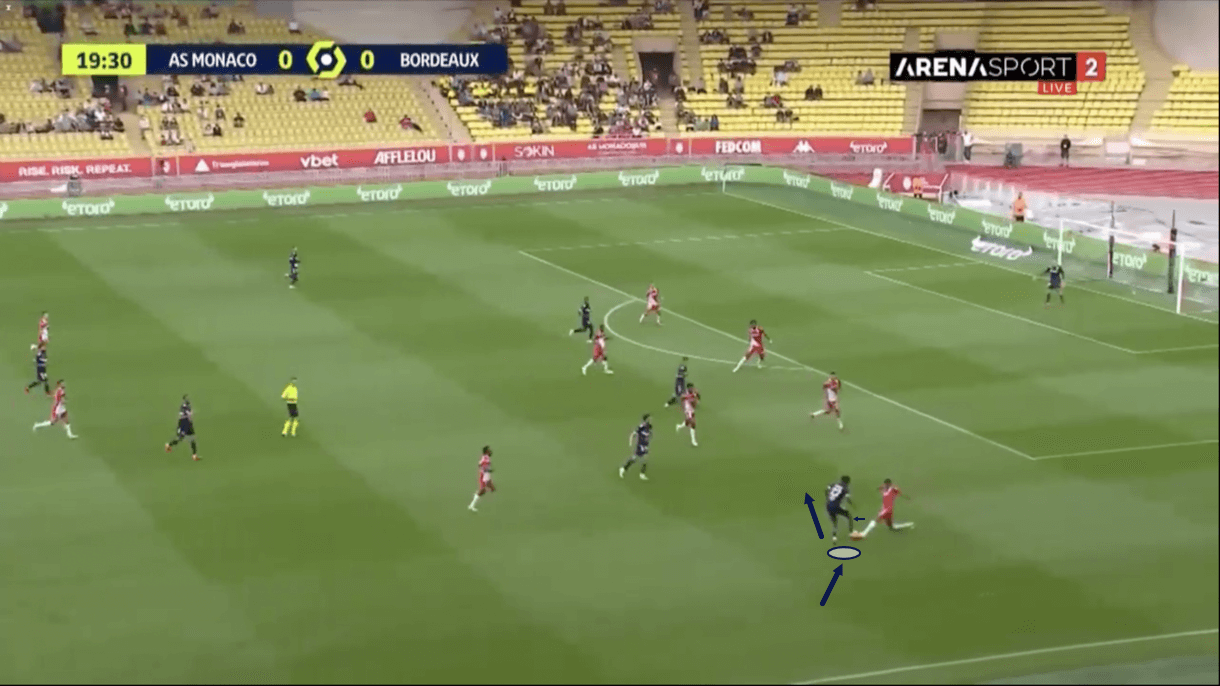
Figure 5 shows an example of Pembélé in possession on the right-wing, inside the final third. Just before this image, the wing-back dribbled towards this opposition full-back, drawing them in and getting them to commit to a challenge. Here, Pembélé’s goal was to get the defender to make the first move, at which point he could react and try to take the ball past him, which is exactly what happens. As play moves on from here, we see the Frenchman drag the ball back away from the defender, taking it out of their reach. Then, Pembélé knocked the ball centrally with the inside of his right foot before following and exiting towards the centre.
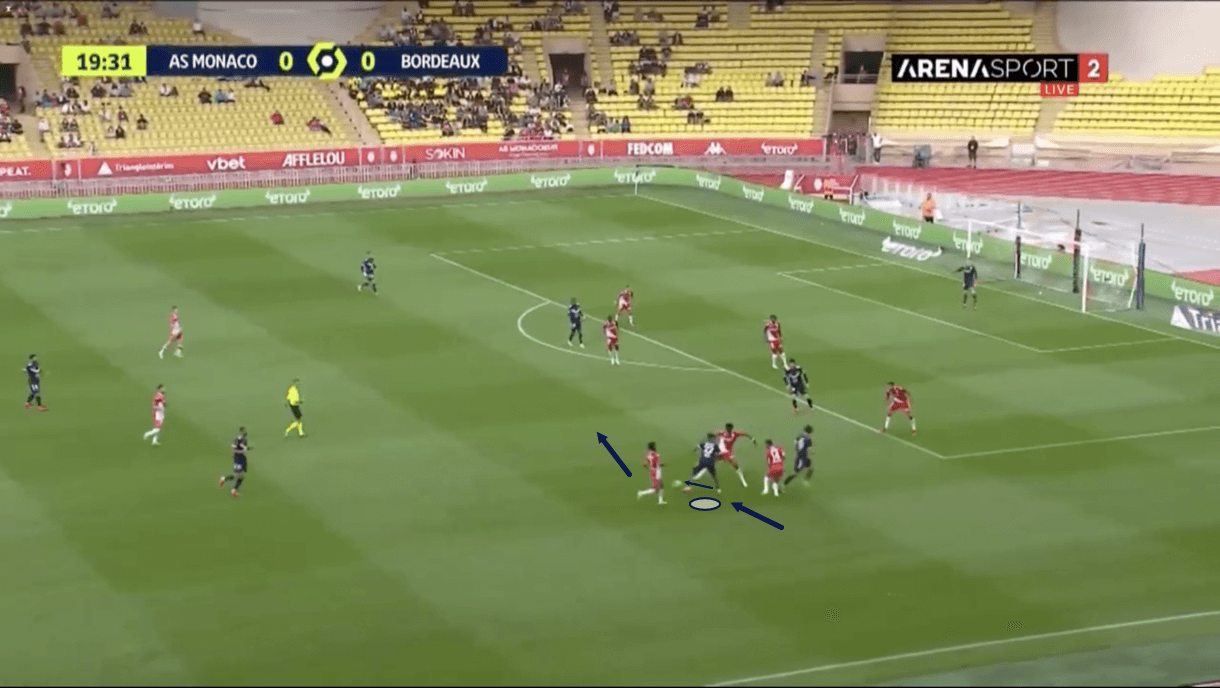
Another opposition player was attracted towards Pembélé as he moved into the centre, which we see in figure 6. The Bordeaux man demonstrated good, quick reactions in response to this situation, again waiting for the opposition player to make the first move before performing a similar move to the one he used to beat the previous defender. Pembélé knocked the ball towards his left foot with the inside of his right foot before using his left foot to knock the ball ahead of him, pushing it further into the centre. After this, the wing-back exited in pursuit of the ball again, ending up free, in space, in the centre of the pitch just outside the box — something of a typical ‘number 10’ position.
This passage of play demonstrates Pembélé’s technical dribbling quality; this aspect of his game helps him to take opposition players out of the game inside the final third, while it also provides a significant boost to his ability to play when under pressure and when in tight spaces. Pembélé’s reactions, balance yet again, and ball control are all key attributes that help him to succeed in situations like this.
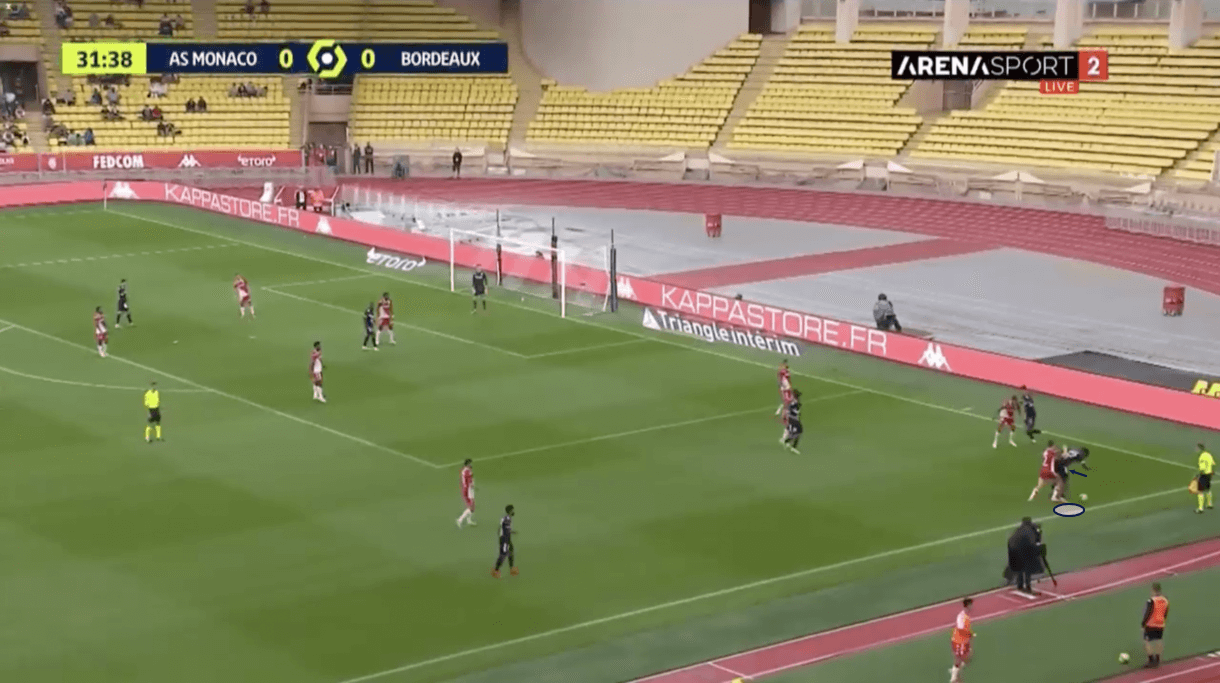
As well as dribbling quality and the rest of his physical qualities that we’ve already discussed, Pembélé brings size and strength to the field for his team. At 19, Pembélé can noticeably still bulk up much more to fill out his frame and improve his strength. Highlighting this is not to say he’s the finished article physically, this is an area that still has plenty of room for improvement. However, at 182cm, Pembélé is quite tall for a full-back/wing-back/winger and can use his size to help protect the ball, which we see an example of in figure 7.
Just before this image, the wing-back received the ball to feet on the right-wing but at this moment, he didn’t have a tonne of attractive options available to him for his next move. To buy himself some more time, Pembélé intelligently opted to protect the ball by placing his feet roughly shoulder-width apart, dropping his hips lower, and bending to extend his glutes. This repelled the opposition player behind him away and thanks to his size and strength, Pembélé was able to hold this position for a couple of seconds, keeping the defender at bay and buying himself time to plan his next move and wait for some space through which he can progress the ball to open up.
As play moves on from this point, Pembélé was able to knock the ball inside with his right foot and exit in pursuit of it. He dribbled through the remaining defenders between him and the box like a slalom course before ultimately getting into a crossing position. This progression from a fairly non-threatening position on the sideline into a more threatening crossing position just on the edge of the box highlights how Pembélé benefitted from his ability to hold up the play for just an extra couple of seconds, giving himself more time to assess the situation before exiting and dribbling through the opposition defenders.
Of course, if he were able to exit quicker and assess the situation with just as much success — even better and maybe this is an area that Pembélé can still improve, in terms of his ability to register and process information on the pitch. However, he used the extra time he bought for himself very well here and he bought the time effectively using his size and strength to hold off a defender, so it’s clear how this ability to protect the ball can be a great asset for Pembélé and his team.
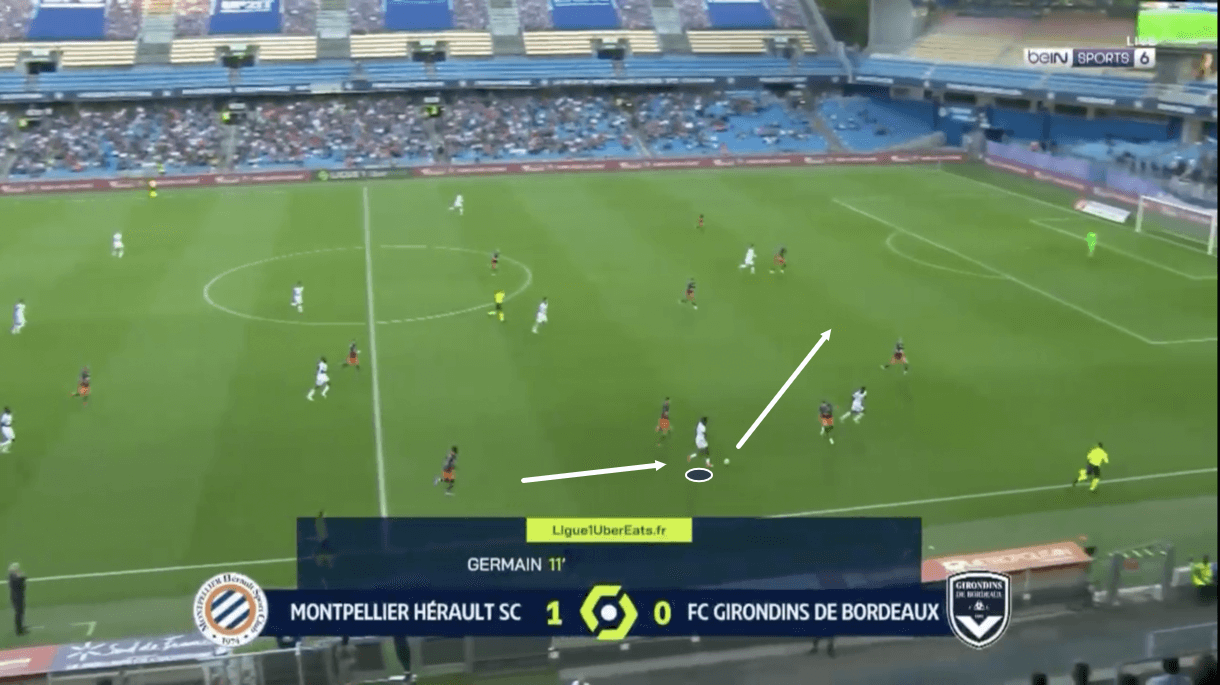
It’s worth noting that while Pembélé mainly likes to carry the ball on the outside of the opposition’s defensive block, travelling down the wing as we saw in figures 1 and 2, it’s also somewhat common to see him carry the ball infield, towards the centre of the pitch, cutting through the opposition’s defensive shape, which was the case as play moved on from figure 8.
As this image shows, Pembélé is carrying the ball up the wing to progress his team upfield. On this occasion, the right-winger ahead of him has opted to run from the half-space onto the wing in front of Pembélé, taking the opposition’s left-back and the space for Pembélé to progress up the wing with him. However, this also then frees up for Pembélé to target with a run into the centre, which is what happens as play moves on from this image. Immediately, on seeing the space out wide disappear, the 19-year-old starts cutting into the centre with the inside of his right foot, running directly at the opposition’s backline.
Pembélé making this run was not a one-off for this occasion, rather, it’s something he’s done on several occasions this season. He has a good understanding with right-winger Javairô Dilrosun which helps Bordeaux to manipulate opposition defenders and create space to progress through. If Dilrosun sits in the half-space, Pembélé will overlap on the wing while if Dilrosun runs wide, Pembélé will make an underlapping run into the half-space. This understanding is important to avoid placing too many players in one vertical line while leaving another unoccupied.
Pembélé demonstrates good positional understanding by reacting to teammates’ movements as he does. Additionally, his decisions to cut inside on occasion help to increase his levels of unpredictability, which can also make him more difficult to defend against 1v1 than if he were someone who just goes in one direction, for example. However, it’s worth noting that he does favour his right foot and will try to keep the ball on his right side, so most of the time will take the ball on the outside when running up the wing.
Defensive positioning, aggression, and alertness
While Pembélé clearly has plenty of positive qualities on the ball, one reason why Petković may be happier to play him at right wing-back with three centre-backs behind him than at right-back with two centre-backs behind him is that the former centre-back isn’t extremely effective as a defender in Ligue 1. The 19-year-old has plenty of room for improvement without the ball. He doesn’t tend to engage in many defensive duels (6.03 per 90) but he also has a relatively poor defensive duel success rate (52%) when compared to other Ligue 1 right-backs/right wing-backs. Pembélé especially pales in comparison to PSG’s Hakimi, who’s engaged in more defensive duels with a far better success rate (62.32%) this season.
If isolated 1v1, Pembélé can be beaten and leave his team exposed at the back. This is something important to take into account when weighing up the positives and negatives of having Pembélé in the side, along with all of his positive attacking qualities, as discussed.
Part of the reason for Pembélé’s defensive weaknesses may be the fact that he has to defend aggressively as a full-back for Bordeaux. This creates a lot of 1v1 scenarios for him, which he comes out on top of just over half the time — less than most Ligue 1 right-backs/right wing-backs this season. Pembélé is a solid defender when taking a more considered, patient approach. He’s good at scanning without the ball, assessing the opposition options around him, and positioning himself accordingly to deal with the threat. However, when forced into more aggressive defensive scenarios, he can be rushed, dragged into challenges prematurely, not as aware of his surroundings, overpowered physically, and ultimately beaten by quality dribblers.
Additionally, while Pembélé is a good size for a full-back, he sometimes lets himself down aerially through his positioning, which needs to improve. Both his physical positioning in relation to the opposition attacker he’s contesting the aerial duel with, and his body positioning entering into the aerial duel are sometimes not at the required standard, leading to the full-back being exposed in the air. However, physically, he has plenty of ability to be a real asset for his team in the air and his 46.15% aerial duel success rate is still not bad compared to other Ligue 1 right-backs/right wing-backs.
So, these are all areas in which the wing-back must look to improve to ultimately raise his ability in defensive duels.
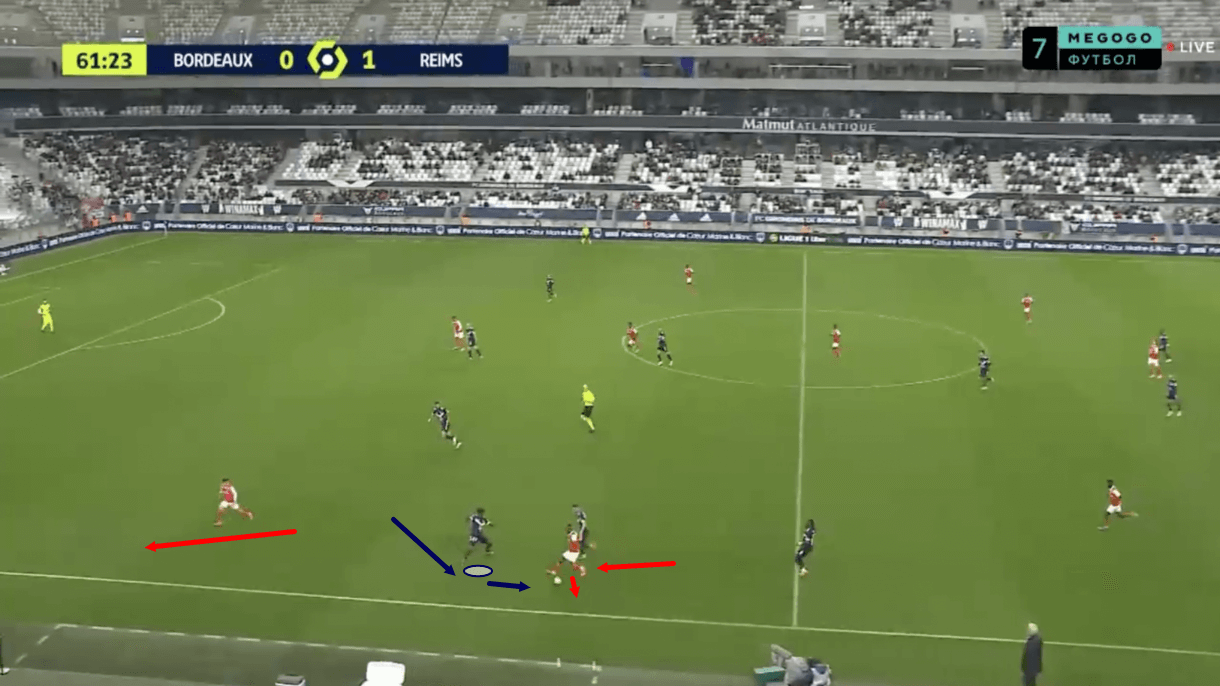
Aggressive defending is an area in which Pembélé can improve a lot but he has shown the capacity for making those improvements this season, with figure 9 providing an example. With an opposition dribbler carrying the ball down the wing, the right wing-back stepped out to confront him. On this occasion, Pembélé positioned himself well between the ball and the runner behind him, having previously been marking this runner. The 19-year-old got himself in position to cut off the passing lane to this more advanced player while closing down the ball carrier, increasing the threat he posed to regaining possession for Bordeaux with every step.
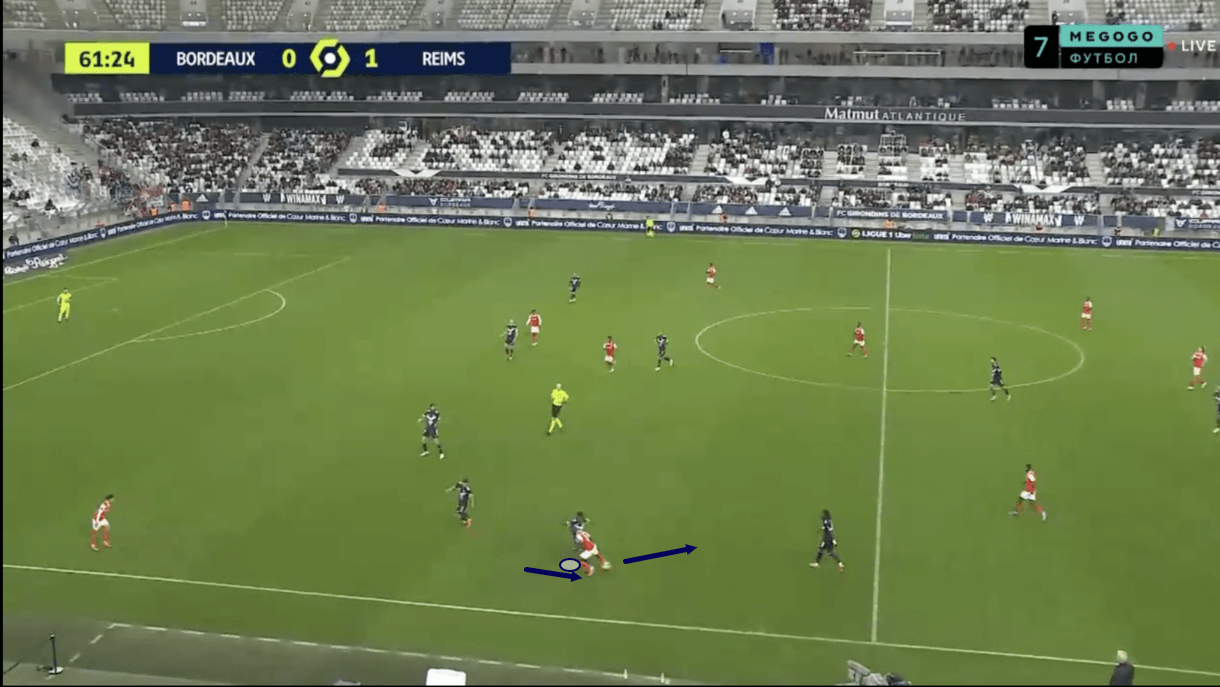
As play moved on into figure 10, we see how Pembélé quickly ended up in a position to regain possession from the ball carrier for his side. The attacker tried to dribble around the wing-back but Pembélé’s aggressiveness and effort to get close to the defender paid off as he was able to stick a foot in and win the ball back for his side here, setting up a counter-attacking opportunity for Bordeaux.
Here, Pembélé’s positioning was on point and played a big role in stifling the opposition’s ball progression. Meanwhile, the defender’s quickness helped him to close down the opposition player before he had much time to reassess his options, allowing him to capitalise on his good positioning and win the ball back. Again, Pembélé is often slightly too quick to commit to a challenge, leaving himself open to be dribbled past, and can be overpowered physically in situations as we see in figure 10. That wasn’t the case on this occasion though, with this example showing a more positive aspect of Pembélé’s defensive ability.
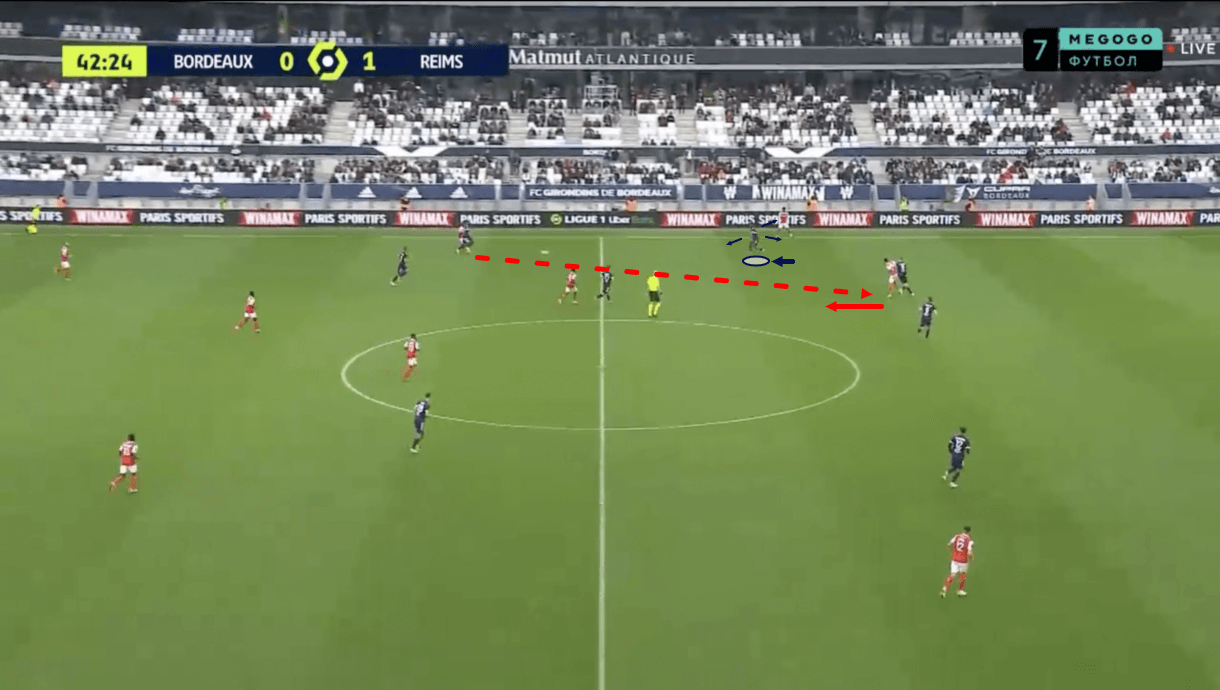
To reinforce an earlier point, Pembélé typically performs much better without the ball when defending more patiently, in situations where he enjoys the time to sit off a bit more while scanning and adjusting his positioning to be prepared for the opposition’s attack to progress to the point where he’s dragged into action. We see an example of one such occasion in figure 11. Here, the wing-back is calm and composed, sitting off more than he was in the previous example thanks to the defensive efforts of the winger in front of him allowing him to sit deeper. He positions himself just in front of the rest of the backline, with the ball on his side of the pitch, ready to pounce and try to intercept should the ball be played out to the left-winger, but without committing too much so he can still retreat if the opposition try to play the ball around him, which was the case here.
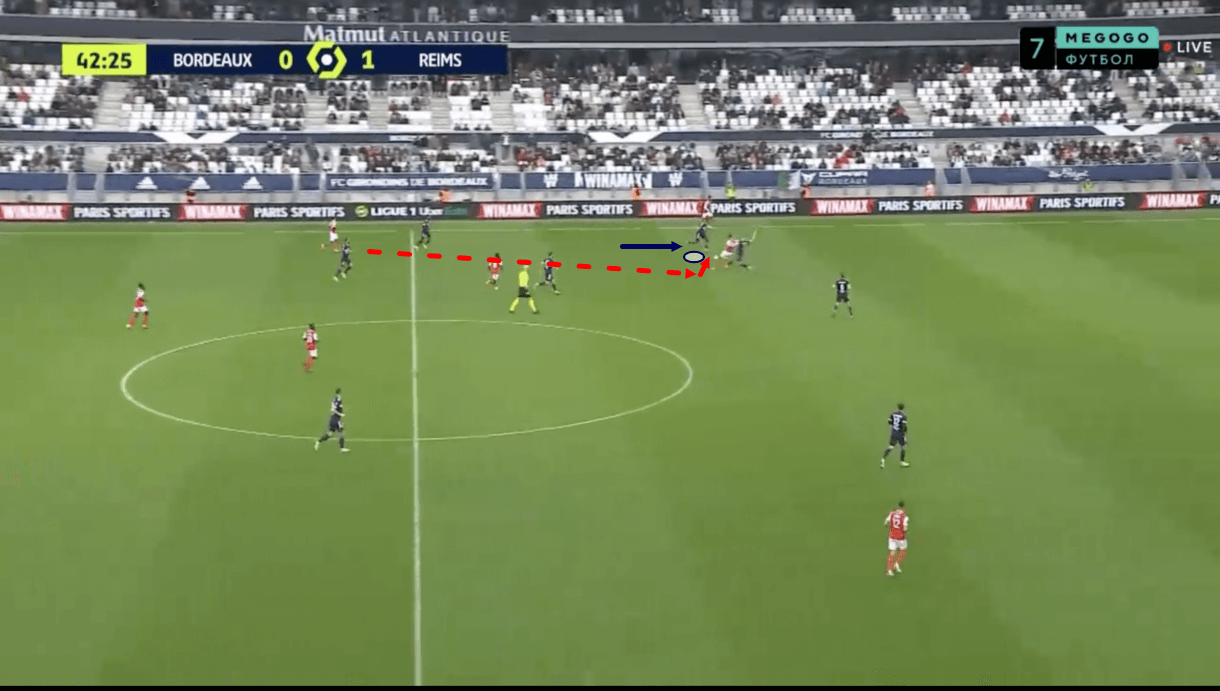
Thanks to his intelligent positioning, Pembélé was positioned well to cut off the passing lane between the centre-forward who received the ball and the left-winger, just like he was prepared to jump into the passing lane between the left-back and the left-winger. This patient defending and good positioning pays off in figure 12, as Pembélé tracked back in time to intercept the centre-forward’s attempted pass out wide to the left-winger. From here, the wing-back could kickstart a counter-attack for Bordeaux.
This passage of play highlights the young Frenchman’s impressive ability to read the game, scanning, positioning, and pace to get back into this passing lane and cut off the pass from the centre-forward to the left-winger. This highlights how some extra protection in front of him can also provide Pembélé with some of the support he needs to defend effectively, as on this occasion, Bordeaux played with just two centre-backs — not three. He wasn’t isolated 1v1 nor was he dragged out of position or forced into aggressive duels. The Bordeaux man could bide his time, focus on his positioning, and wait for the perfect opportunity to jump into action, which he did well.
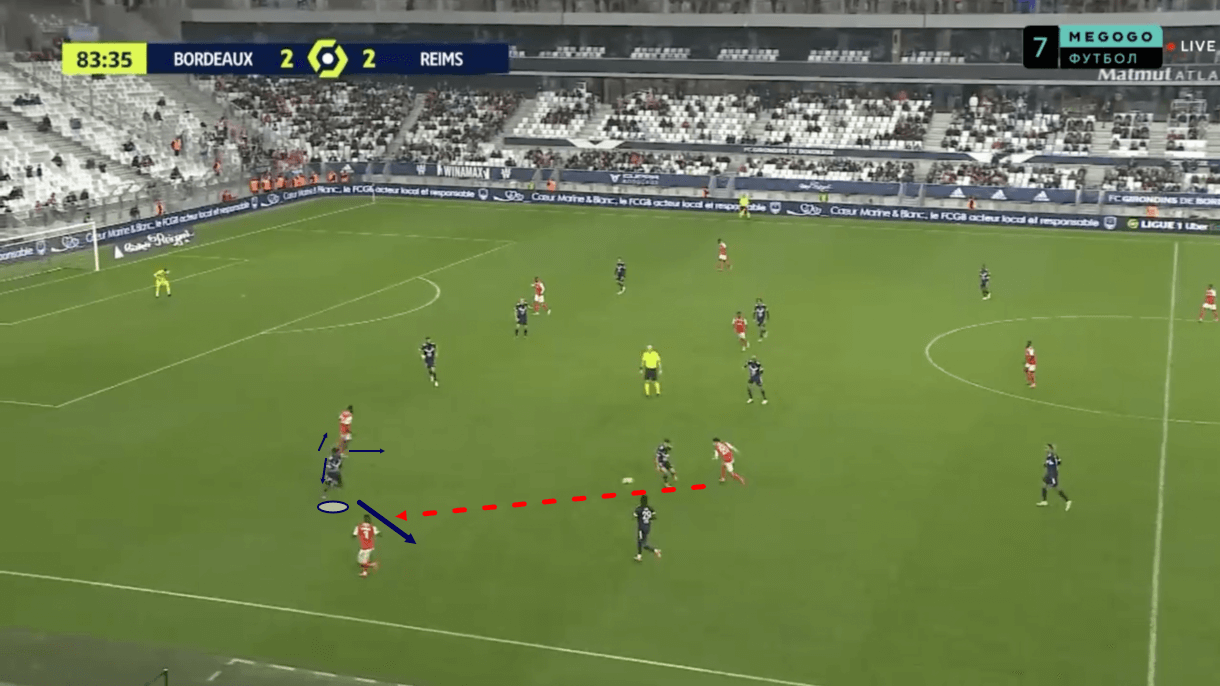
We see another example of Pembélé’s ability to make interceptions here in figure 13. There are plenty of similarities between this scenario and the one we observed in the previous section. Here, Pembélé was able to sit off a bit more thanks to the extra support in front of him, while scanning around and focusing on positioning himself optimally to provide some cover on the attacker behind him as well as the attacker in front of him on the left-wing.
With the opposition midfielder ultimately deciding to send the ball out to the left wing, that was Pembélé’s cue to jump into action and cut off the passing lane to get into the path of this pass and regain possession for Bordeaux. This highlights the 19-year-old’s impressive alertness, as he had to retain good concentration to react to the pass being played and execute his desired reaction in response. Again, just like the previous example, Pembélé was positioned well to react to a few different situations, depending on what option the opposition passer chose. As this pass was played out wide, he was at a good distance — considering his impressive pace and acceleration — to get into the passing lane in time to win the ball back.
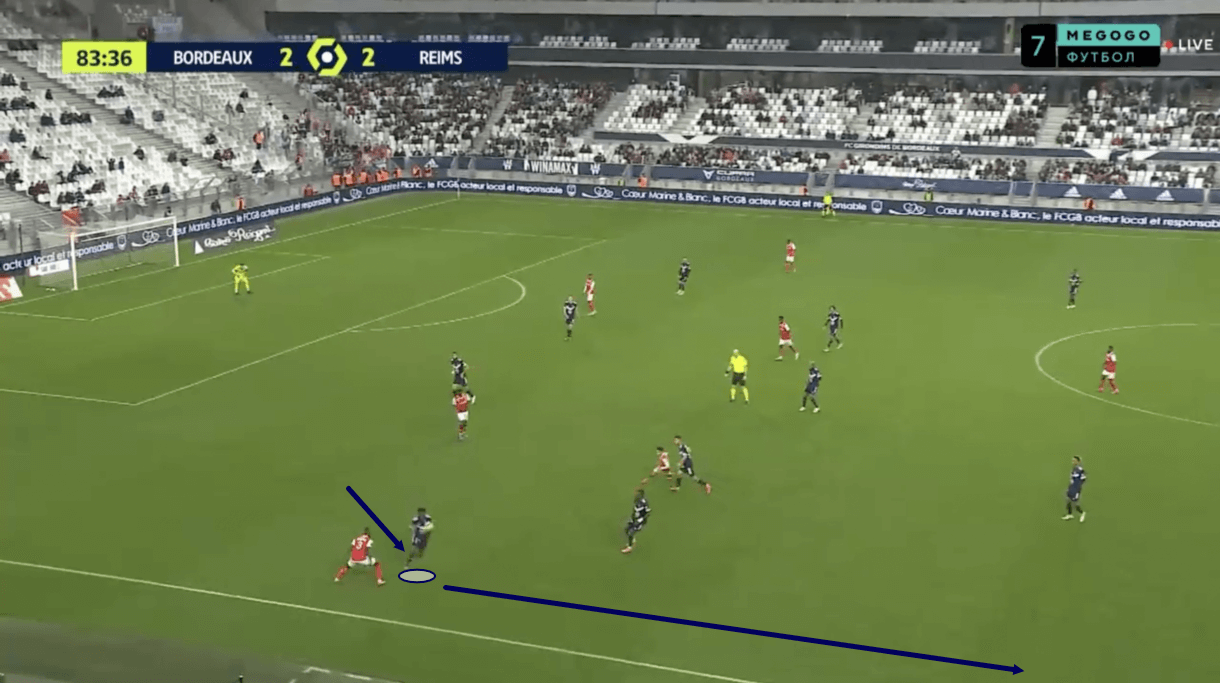
As play moves on into figure 14, we see that Pembélé was quick enough to nick the ball away from the intended receiver just in time before he went on to knock it down the line and start another counter-attack for Bordeaux.
All of these examples highlight Pembélé’s ability to start counter-attacks which, combined with his own counter-attacking threat led by his pace and dribbling quality, is in and of itself a major threat for the opposition. These images also highlight that as long as Pembélé is given some support, either from an additional centre-back behind him or from a defensively-diligent winger in front of him, he is serviceable in defence.
The 19-year-old has plenty of positive defensive qualities and is still improving this area of his game. At present, he’s more comfortable defending deeper and in a more patient manner, compared to when he’s forced to defend aggressively. His spatial awareness, positioning, reactions and pace are some of his best defensive qualities. However, he needs to improve his aerial positioning and strength, while he’s relatively weak in 1v1s and can be exposed when committing too early on occasions, similarly to how we saw his opponents act when analysing his positive dribbling earlier in this scout report.
Passing issues
Pembélé is an excellent asset in ball progression due to his positioning, ability to receive the ball well, spatial awareness, physical qualities and dribbling ability, all of which we discussed earlier. When progressing the ball himself, the 19-year-old relies heavily on his ball-carrying ability, as opposed to his passing ability, however.
The Bordeaux man’s average pass length is just 14.45m, which is very short compared to other Ligue 1 right-backs/right wing-backs/right midfielders. However, his overall passing accuracy is just 76.1%, which isn’t impressive. There could be several reasons that explain this but the main one for me lies in his lateral passing. When passing backwards, as you’d imagine, Pembélé is fine and reliable and relative to other right-backs/right wing-backs in Ligue 1. His forward passing is also fairly reliable; he doesn’t tend to try anything too risky, in general, with his forward passing — making a fairly average 4.27 progressive passes per 90 with a poor 70.59% accuracy — indicating that he’s probably justified in not trying more progressive passes at present and sticking to playing more reliable, short forward passes that don’t look to progress the team too far but find a teammate who may possess the ability to drive the team further upfield, resulting in his forward passing accuracy being 72.55% — which ranks better amongst Ligue 1 right-backs/right wing-backs than his progressive passing does.
However, Pembélé’s lateral passing accuracy this season stands at 73.58%, which is quite poor, especially given that lateral passes make up the bulk of his overall passes.
The Frenchman has fared poorly under pressure at times, resulting in him getting rushed into playing sloppy sideways passes that let the opposition regain possession fairly easily.
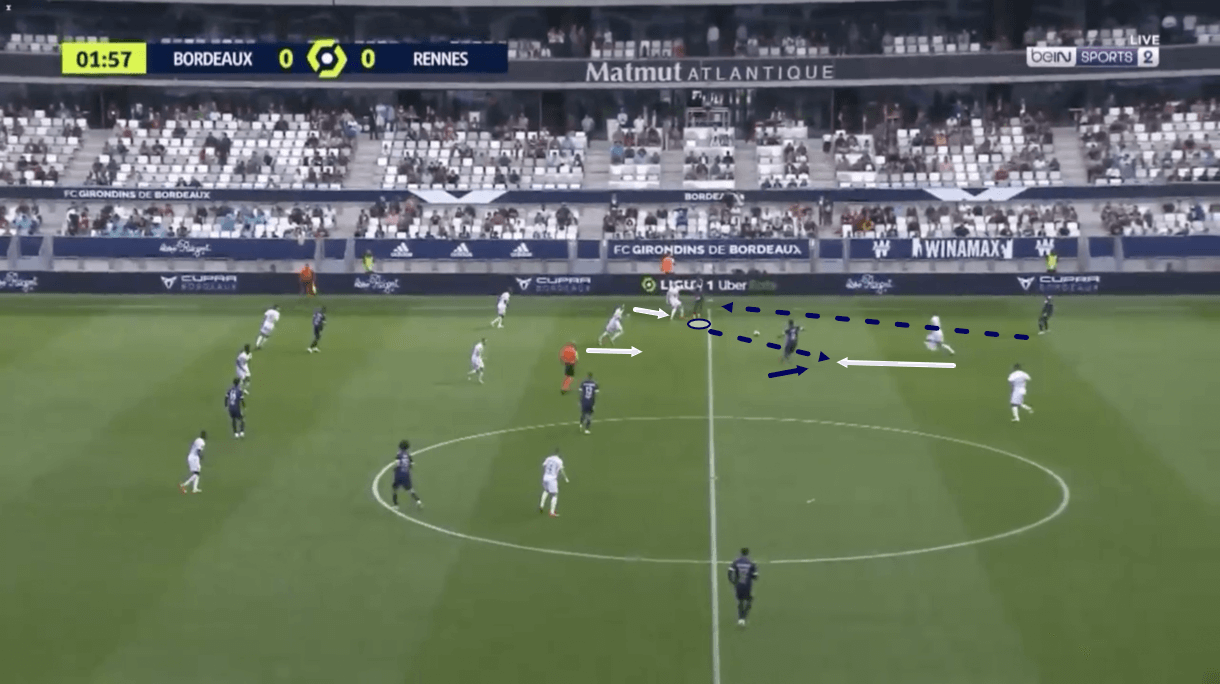
We see an example of Pembélé losing possession with a misplaced lateral pass in figure 15. Just before this image, he received a pass to feet out wide and immediately attracted pressure from the opposition’s left-back who got tight to the wing-back. Under pressure, Pembélé opted to try and play the ball inside to the nearest central teammate but the pass was played too far behind the intended recipient, allowing the opposition’s centre-forward to nip in and snatch possession away from Bordeaux, resulting in a Rennes counter-attack from a very dangerous, threatening position inside of Les Girondins’ half.
This isn’t a one-off, but something we see plenty of the time from Pembélé. Perhaps it’s mainly through the opposition’s effective pressure unsettling the wing-back’s nerves and concentration, but this is something that Pembélé has got to iron out this season if he is to earn a place in PSG’s squad as a backup to Hakimi — if that’s what he and the club want — next season. At present, the degree at which the right-back gives away possession cheaply via misplaced sideways passes in midfield is far too high, especially for a club of PSG’s standards, so the 19-year-old needs to work on his passing technique under pressure.
Decision-making issues
In the final section of this scout report, I’m going to take some time to focus on Pembélé’s decision-making. There is usually a lot of room for improvement in this area for young players and Pembélé is no different in that regard, having just turned 19 in September. He’s a player with great physical, technical and mental qualities, as we’ve discussed but he’s far from the finished article. One key area of improvement for the PSG academy product is in his decision-making and we’ll highlight a couple of specific examples as to where Pembélé could look to improve his decision-making in this section of analysis.
Firstly, as a wing-back and the widest member of his team’s frontline in attack on the right side, crossing is an important part of Pembélé’s game. Hakimi at PSG — an elite crosser — has played 2.2 crosses per 90 this season with a very good 43.48% accuracy, while Pembélé has played a high number of crosses (3.14 per 90) and managed to achieve 36% accuracy, which isn’t matching Hakimi but isn’t bad by any stretch. It’s a decent crossing success rate but one that leaves plenty of room for the teenager to improve and take his game to another level.
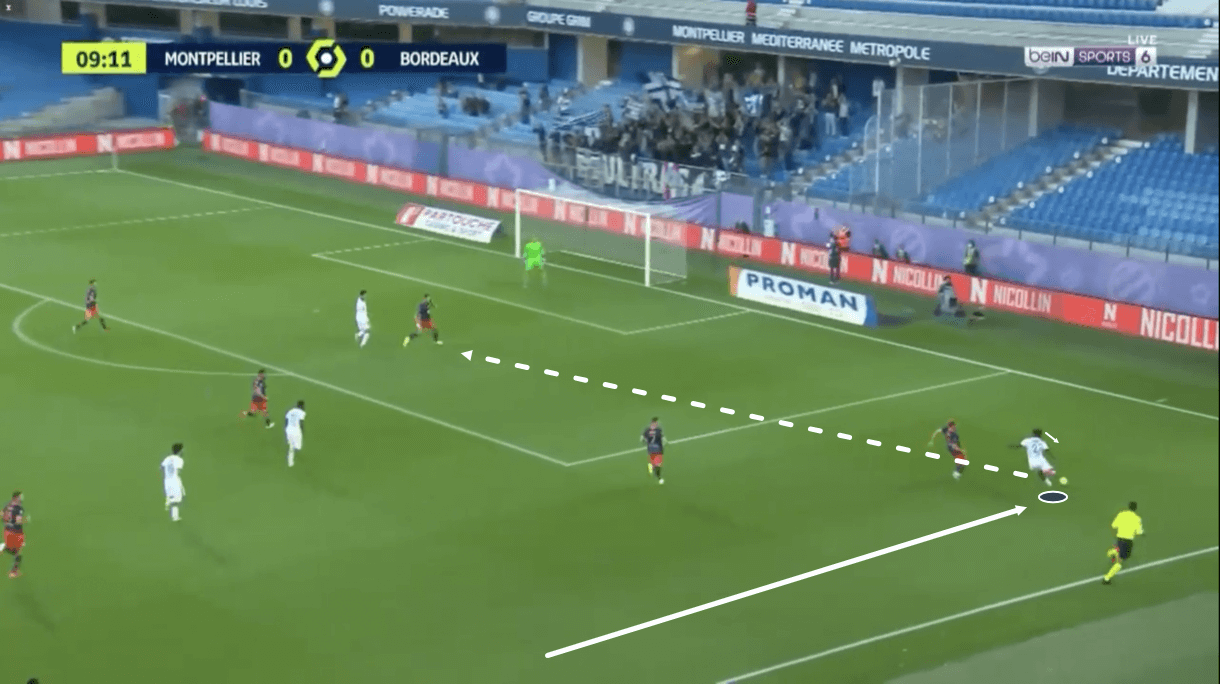
Figure 16 shows a typical example of Pembélé driving up the right-wing. Just before this image, the wing-back was played through on goal and given space to run into. The 19-year-old ultimately used that space well to get into the crossing position we see here. Pembélé loves to drive into the box with the ball and will do that where possible to create good low driven cross opportunities. However, sometimes he’s forced to stay wider, which was the case here. Often when forced to stay wider, though, Pembélé still decides to try a low driven cross and they very rarely work when he’s so far wide, with such a distance between him and the intended recipient.
A different style of cross, such as a floated ball towards the back post or a medium-height whipped ball across the face of goal, could be better options in this type of situation but the wing-back rarely opts for them. Whether it’s out of a lack of confidence in his technical quality or overconfidence in this style of cross in these specific situations, Pembélé must overcome whatever is preventing him from switching up his style of cross more, especially when positioned deeper and wider.
Additionally, it’s common to see Pembélé hit crosses with his head down while driving forward at high pace. Again, this is fine when inside the box and at a closer distance to the receiver where accuracy is easier to achieve and striking the ball with power can be very effective. However, when positioned wider, with a greater distance between him and the striker in the box, Pembélé would do well to get his head up more and take the time to pick out his man. This will help his decision-making, make him more unpredictable on the ball, and surely lead to an improved cross success rate, as these low driven crosses from such wide positions aren’t working out as it is.
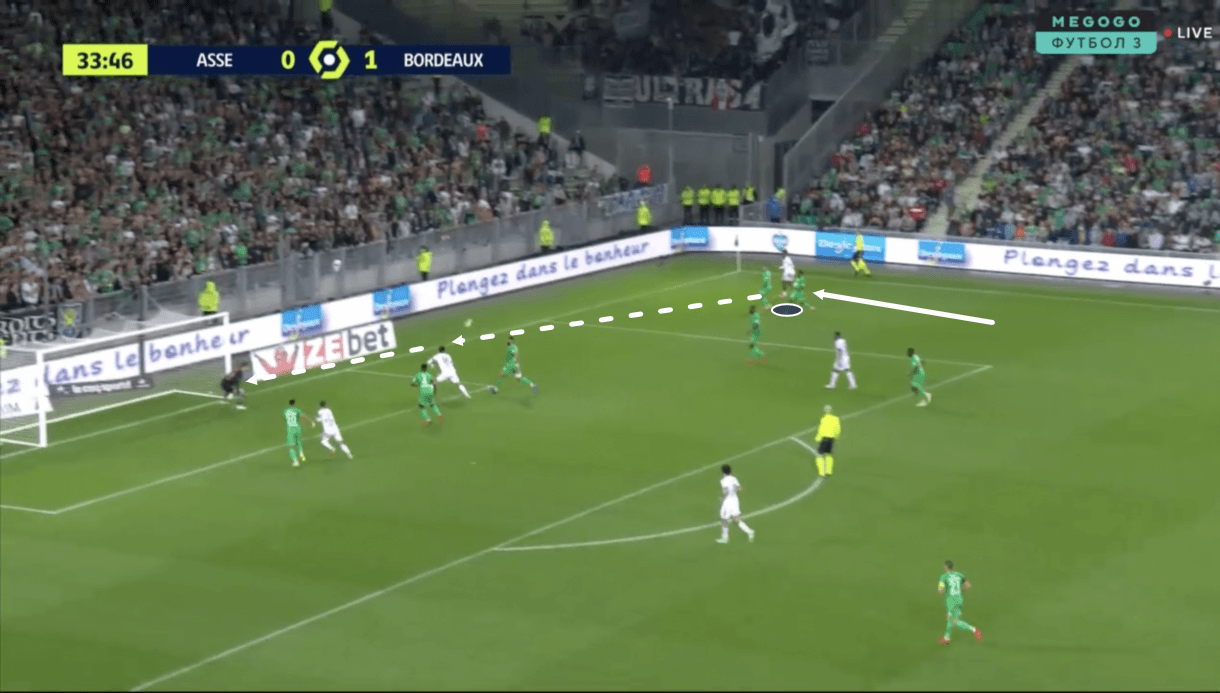
Figure 17 shows an example of one occasion earlier this season when Pembélé did opt for a whipped ball across the face of goal from a wider position like the one he occupied in figure 16, and it was one of his most dangerous crosses this term, with the striker narrowly missing the target with his header. If Pembélé prefers low driven crosses, that’s fine as long as he’s set up the best scenario in which to use them. However, when positioned so much wider with so many more bodies between him and the target, it may help him to mix things up a bit more and attempt different types of crosses that would be more effective from these positions.
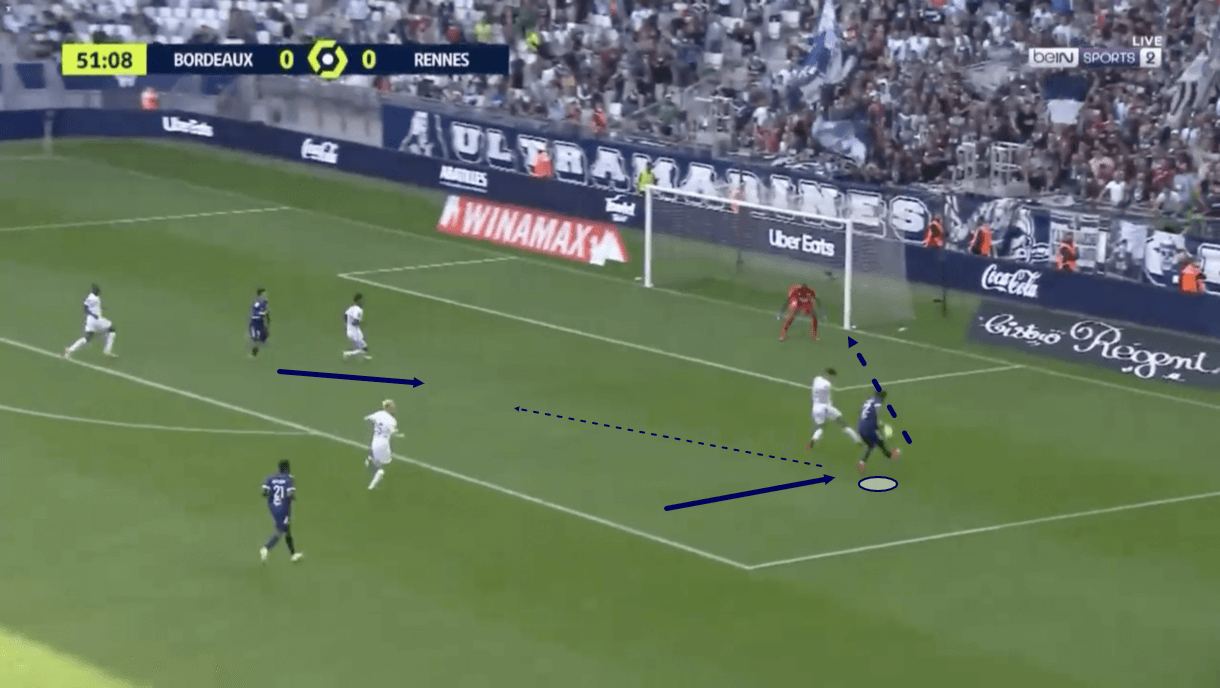
Lastly, Pembélé loves to take shots on. He’s taken the most shots (1.63 per 90) of any right-back/right wing-back in Ligue 1 this season. Additionally, his shot accuracy is not terrible when compared to other Ligue 1 right-backs (38.46%). However, many of Pembélé’s shots are not threatening enough and come from positions and situations when he may be better off taking a different option, as was the case in figure 18.
Just before this image, Pembélé carried the ball into the box — one of his favourite things to do — progressing into the position we see him here, where he ultimately decided to try the goalkeeper. While the wing-back’s shot was on target, it was straight at the ‘keeper and failed to test him at all. This is one of the big problems with shooting from a tight angle like this. As well as your target being smaller, the angle makes the ‘keeper bigger and more difficult to miss. It’s been fairly common to see Pembélé rush into shots at times this season, like we saw on this occasion, hence why he’s ended up taking so many shots per 90. It’s not necessarily a list you need to be at the top of and based on the quality of shooting opportunities Pembélé’s been taking this season, he would probably do well to reduce his shot volume, especially when better options are available.
In figure 18, for example, a teammate was just starting a beautiful and threatening curved run around the centre-back on the penalty spot, which Pembélé could’ve spotted had he got his head up and looked around, instead of keeping his head down until he got it up to shoot. Again, this highlights that the 19-year-old must try to get his head up more often to avail of the information available on the pitch and ultimately take better crossing opportunities. Instead of laying the ball across into the striker’s path here, he went for the shot from a far less valuable position, leading to the unsuccessful end of this attack.
So, getting his head up more and shooting less from tight angles would likely benefit Pembélé’s productivity in the final third.
Conclusion
To conclude this tactical analysis piece, while I don’t think it’s safe to say that Pembélé is the undisputed heir to Hakimi’s right-back throne at Le Parc des Princes, he’s got great potential to compete with the Moroccan for that position in years to come if he continues his development and makes some improvements where necessary — including some of the areas I’ve highlighted in this scout report.
At present, Pembélé is a great attacking asset who loves to run at defenders, especially on the outside, and loves to carry the ball into the box before hitting low driven crosses. His dribbling quality and rapid pace make him stand out among Ligue 1’s right-backs, while he’s fairly reliable when defending deep and unrushed. However, he still needs to make some improvements in key areas like his defending in higher positions, passing under pressure, shot and cross selection, and strength to cement himself in the upper echelons of Ligue 1’s right-backs permanently.





Comments